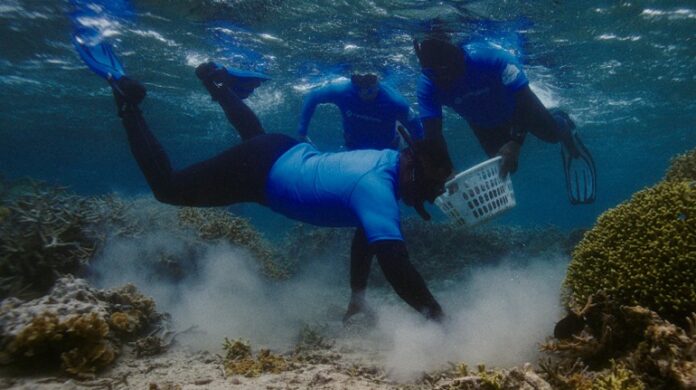Riyadh, KSA, 24 Jan 2025 – Samsung Electronics Co., Ltd. today announced it has expanded its commitment to helping protect the world’s oceans in collaboration with like-minded partners. Building upon its efforts to address the pervasive challenge of plastic waste by transforming discarded fishing nets into a high-quality recycled material used in Galaxy devices, Samsung is taking a significant step forward with its latest project to restore the damaged marine ecosystems. The company is announcing support for a new initiative to equip local communities and experts on the front lines of coral reef restoration with mobile technology, bringing the challenges faced by this largely hidden ecosystem into focus.
Delivering Meaningful Progress for the World’s Oceans
Samsung is dedicated to protecting the environment for future generations, a commitment that drives the company’s innovation and positive impact for both people and the planet. This dedication has led Samsung to focus on enhancing ocean health with its innovative technology.
Starting with the Galaxy S22 series in 2022, Samsung incorporated recycled discarded fishing nets – also known as ghost nets—in Galaxy devices. Since then, Samsung has continued to scale its use of this recycled material across all Galaxy mobile products[1], aiming to mitigate the damage that ocean-bound plastic[2] inflicts on fragile marine ecosystems[3].
Now, Samsung is taking these actions one step further by joining forces the U.S.-based nonprofit organization Seatrees and the University of California San Diego to explore new, innovative solutions for reef restoration. The Galaxy camera technology provided to local coral reef restoration activists and researchers in coastal communities will aid their efforts to restore reefs impacted by climate change and pollution through improved monitoring of restoration success.
“We initiated our commitment to the world’s oceans when we transformed discarded fishing nets into key components of the Galaxy S22 series, which to date, has incorporated more than 150 tonnes of discarded fishing nets into key components of Galaxy devices,” said Stephanie Choi, EVP & Head of Marketing of Mobile eXperience Business at Samsung Electronics. “This year, we are furthering our commitment to the oceans by creating purposeful technology that helps protect and restore damaged marine ecosystems around the world.”
Together, with Seatrees, Samsung is giving new purpose to Galaxy technology to further innovative solutions that improve the health of the world’s oceans. The company is supporting non-profits and local community members working in Fiji, Indonesia and the United States with Galaxy technology to help restore coastal ecosystems. By leveraging mobile technology, these organizations aim to democratize and to create a more efficient process for coral restoration in reefs damaged by climate change, overfishing and ocean pollution, such as discarded fishing nets.
An Innovative Approach to Reef Monitoring and Restoration
Despite covering less than 1 percent of the ocean floor, coral reefs support approximately 25 percent of all marine life, making them one of Earth’s most biodiverse ecosystems[4]. Millions of people around the world also rely on reefs as a source of food, income and coastal protection. At the current pace of decline, reefs are at risk of disappearing by 2050[5].To support the rapid development of coral reef stewardship projects globally, this initiative will provide advanced monitoring technology that leverages mobile devices as a readily-accessible technology platform.
While efforts to revive coral reefs have existed for decades, researchers are seeking new ways to improve this process. Scientists from UC San Diego’s Scripps Institution of Oceanography and local communities use photogrammetry[6] to collect a variety of data – including photographs of coral – to analyze the health and growth of reefs. This allows them to then develop 3D models of the reef, helping researchers identify appropriate interventions that mitigate the effects of climate change on the corals.
Accurate data is essential to researchers gaining a deeper understanding of how coral restoration efforts are affecting the reefs, and therefore help protect a greater number of reefs around the world. However, capturing accurate and vivid photos of coral reefs is not a simple task. Images can suffer from motion blur as divers swim over reefs capturing thousands of photographs, leading to less accurate data. Similarly, water absorbs warm colors like reds and oranges, also known as long wavelength light, distorting the accuracy of the captured images and resulting in photos that are darker and bluer than they appear to the naked eye.
Knowing that an accurate underwater camera is crucial to improving coral restoration efforts globally, Samsung collaborated to overcome these challenges by advancing Galaxy technology as a purposeful tool for coral restoration. Samsung developed a customized camera mode, called Ocean Mode,[7] made exclusively for this partnership. Ocean Mode optimizes the native Galaxy camera to ensure efficient and high-quality image capture of coral reefs while underwater. It reduces motion blur and optimizes the camera’s white balance to enhance underwater content capture, ensuring accurate photos are sent to researchers. This, in turn, improves coral restoration efforts through improved analysis of restoration success.
“Design and implementation of coral reef restoration need to be informed by reliable information about what works and what doesn’t,” said Dr. Stuart Sandin, Marine Ecologist at Scripps Institution of Oceanography and Director of the Center for Marine Biodiversity and Conservation. “Mobile technologies offer an exciting opportunity to expand access to this information.”
“By building on technology that is both innovative and accessible, this collaboration has the potential to help bridge barriers and simplify the process for research and restoration, enabling more effective science-based stewardship at scale,” added Dr Eliah Aronoff-Spencer, Human-Centered Technologist and Director for UC San Diego’s Center for Health Design.
“This partnership represents a collective effort of people and organizations coming together to rebuild hope by restoring ocean ecosystems,” said Michael Stewart, Co-Founder and Director of Seatrees. “By collaborating with Samsung and UC San Diego, we can share their innovative tools to help local communities efficiently restore reefs at scale.”
Throughout 2024, Samsung supported coral restoration projects in regions that have suffered coral reef declines, including Bali, Indonesia; Viti Levu Island, Fiji; and Florida, USA, and over 11,000 coral fragments having already been planted at these project sites. Committed to using technology for good, Samsung and its collaborators are united around a shared goal of restoring marine ecosystems and preserving the world’s oceans for future generations. Grounded in the spirit of open collaboration and by leveraging Samsung’s expansive scale, the organizations will continue to expand the initiative to more regions in the months ahead.
[1] Recycled materials can be found in all Galaxy devices released in and after 2022.
[2] Ocean-bound plastic is abandoned plastic waste of all sizes (micro-plastics, mezzo-plastics and macro-plastics) that are located within 50km of shores in communities or areas.
[3] The amount of ocean-bound plastic used is different for each device. Please visit Samsung Sustainability website for more information.
[4] Smithsonian Museum of Natural History
[5] United Nations Environment Program
[6] Photogrammetry is the science of obtaining reliable information about physical objects and the environment through the process of recording, measuring and interpreting photographic images
[7] Ocean Mode is exclusively supported for this project and is not available in products for general consumers





